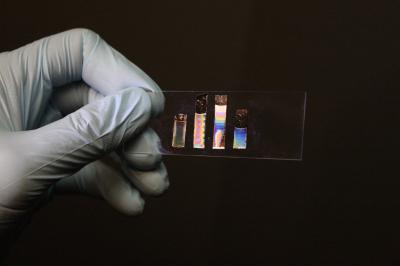Viruses harnessed as molecular building materials

Researchers at the University of California at Berkeley have developed a technique to coax benign viruses called M13 phages to serve as structural building blocks for complex biological materials.

The materials created with the help of viruses could eventually be used to create complex biological tissues, such as cornea, skin and bones. Credit: Woo-Jae Chung, UC Berkeley
"We took our inspiration from nature," said Seun-Wuk Lee, an associate professor of bioengineering at UC Berkeley who describes his team's self-templating, bio-material assembly process in the journal Nature. "Nature has a unique ability to create functional materials from very basic building blocks. We found a way to mimic the formation of diverse, complex structures from helical macromolecules, such as collagen, chitin and cellulose, which are the primary building blocks for a wide array of functional materials in animals and plants."
Lee points to the blue-faced Mandrill as as a source of inspiration. It derives its coloring not from pigment, but from the specific scattering of light formed when thin fibers of collagen are twisted and layered in its skin.
The researchers began studying collagen, particularly the factors influencing the formation of the protein's hierarchical structures. But they hit a wall. "Unfortunately, collagen is a difficult material to study because it is hard to tune its physical and chemical structures. We needed a convenient model system to solve this problem," said Lee.
The teamed turned to the common bacteria-attacking virus, the M13 bacteriophage, which is routinely engineered for applications from nanomaterials to green energy and harmless to humans. They found that its long, "chopstick-like" shape with a helical groove on the surface closely resembled collagen fibers.
The scientists added varying concentrations of the virus to a soup of saline solution in. Next, they dipped a sheet of glass into the bath of M13 and pulled it out at slow, precise speeds to control the liquid's viscosity, surface tension, and rate of evaporation--all factors which determined the type of pattern formed by the viruses. As each sheet emerged, a fresh film of viruses was attached. This technique altered the physical environment for the viral filaments and ultimately produced three distinct film patterns.
The next step was to engineer the virus to express specific peptides that influence the growth of soft and hard tissue for use in biomedical applications. They used the resulting viral films as tissue-guiding templates to form a composite similar to tooth enamel that could potentially be used as regenerative tissue.
According Lee, their technique's simplicity is key; by setting very specific parameters, they just let self-assembly slowly take place: "We let this run overnight, and by the next morning there were trillions of viral filaments arranged in patterns on our substrate."
One of their key findings, Lee said, is that "we have started to understand nature's approach to creating such complex structures, and we have developed an easy way to mimic and even extend it."
Sources: UC Berkeley, NSG.gov